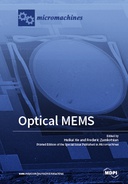Explore

Optical MEMS
Huikai Xie and Frederic Zamkotsian Aix
2019
0 Ungluers have
Faved this Work
Login to Fave
Optical microelectromechanical systems (MEMS), microoptoelectromechanical systems (MOEMS), or optical microsystems are devices or systems that interact with light through actuation or sensing at a micro- or millimeter scale. Optical MEMS have had enormous commercial success in projectors, displays, and fiberoptic communications. The best-known example is Texas Instruments’ digital micromirror devices (DMDs). The development of optical MEMS was impeded seriously by the Telecom Bubble in 2000. Fortunately, DMDs grew their market size even in that economy downturn. Meanwhile, in the last one and half decade, the optical MEMS market has been slowly but steadily recovering. During this time, the major technological change was the shift of thin-film polysilicon microstructures to single-crystal–silicon microsructures. Especially in the last few years, cloud data centers are demanding large-port optical cross connects (OXCs) and autonomous driving looks for miniature LiDAR, and virtual reality/augmented reality (VR/AR) demands tiny optical scanners. This is a new wave of opportunities for optical MEMS. Furthermore, several research institutes around the world have been developing MOEMS devices for extreme applications (very fine tailoring of light beam in terms of phase, intensity, or wavelength) and/or extreme environments (vacuum, cryogenic temperatures) for many years. Accordingly, this Special Issue seeks to showcase research papers, short communications, and review articles that focus on (1) novel design, fabrication, control, and modeling of optical MEMS devices based on all kinds of actuation/sensing mechanisms; and (2) new developments of applying optical MEMS devices of any kind in consumer electronics, optical communications, industry, biology, medicine, agriculture, physics, astronomy, space, or defense.
This book is included in DOAB.
Why read this book? Have your say.
You must be logged in to comment.
Rights Information
Are you the author or publisher of this work? If so, you can claim it as yours by registering as an Unglue.it rights holder.Downloads
This work has been downloaded 205 times via unglue.it ebook links.
- 62 - pdf (CC BY-NC-ND) at Unglue.it.
Keywords
- 2D Lissajous
- 3D measurement
- achromatic
- angle sensor
- bio-optical imaging
- confocal
- Cu/W bimorph
- digital micromirror device
- digital micromirror device (DMD)
- DMD chip
- dual-mode liquid-crystal (LC) device
- echelle grating
- electromagnetic actuator
- electrostatic
- electrothermal actuation
- electrothermal bimorph
- field of view (FOV)
- flame retardant 4 (FR4)
- fluorescence confocal
- fringe projection
- higher-order modes
- Huygens’ metalens
- Infrared
- infrared Fabry–Perot (FP) filtering
- input shaping
- intraoperative microscope
- large reflection variations
- laser stripe scanning
- laser stripe width
- LC micro-lenses controlled electrically
- MEMS mirror
- MEMS scanning micromirror
- MEMS scanning mirror
- metalens
- metasurface
- micro-electro-mechanical systems (MEMS)
- microscanner
- MLSSP
- n/a
- NIR fluorescence
- ocular aberrations
- open-loop control
- Optical Coherence Tomography
- Optical Switch
- parametric resonance
- polarization dependent loss (PDL)
- programmable spectral filter
- quality map
- quasistatic actuation
- Reliability
- residual oscillation
- resonant MEMS scanner
- scanning micromirror
- signal-to-noise ratio (SNR)
- spectrometer
- stray light
- tunable fiber laser
- two-photon
- usable scan range
- variable optical attenuator (VOA)
- vibration noise
- wavefront sensing
- wavelength dependent loss (WDL)
Links
DOI: 10.3390/books978-3-03921-304-7Editions


